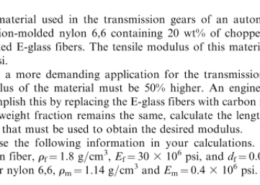Share
P3.27. The material used in the transmission gears of an automobile is an injection-molded nylon 6,6 containing 20 wt% of chopped randomly oriented E-glass fibers. The tensile modulus of this material is 1.25 × 10° psi. In a more demanding application for the transmission gears, the modulus of the material must be 50% higher. An engineer wants to accomplish this by replacing the E-glass fibers with carbon fibers. If the fiber weight fraction remains the same, calculate the length of carbon fibers that must be used to obtain the desired modulus Use the following information in your calculations. (a) For the carbon fiber, Pr= 1.8 g/cm. Ef= 30 × 106 psi, and df= 0.0006 in, and (b) for nylon 6,6, Pm-114 g/cm 3 and Em-0.4 × 106 psi
ReportQuestion
Please briefly explain why you feel this question should be reported.
P3.27. The material used in the transmission gears of an automobile is an injection-molded nylon 6,6 containing 20 wt% of chopped randomly oriented E-glass fibers. The tensile modulus of this material is 1.25 × 10° psi. In a more demanding application for the transmission gears, the modulus of the material must be 50% higher. An engineer wants to accomplish this by replacing the E-glass fibers with carbon fibers. If the fiber weight fraction remains the same, calculate the length of carbon fibers that must be used to obtain the desired modulus Use the following information in your calculations. (a) For the carbon fiber, Pr= 1.8 g/cm. Ef= 30 × 106 psi, and df= 0.0006 in, and (b) for nylon 6,6, Pm-114 g/cm 3 and Em-0.4 × 106 psi

Answer ( 1 )
Please briefly explain why you feel this answer should be reported.